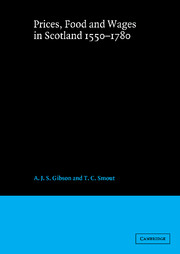Book contents
- Front Matter
- Contents
- Figures
- Tables
- Acknowledgements
- Abbreviations
- A note on Scottish and English money
- Map of Scottish counties and principal burghs
- 1 Introduction
- 2 The system of burgh price regulation
- 3 The system of county fiars
- 4 Press reports of monthly market prices
- 5 Trends and fluctuations in grain-price movements
- 6 The price of animals and animal products
- 7 Food
- 8 Wages in money and kind
- 9 Real wages
- Appendix I Scottish weights and measures, 1580–1780
- Appendix II Accessing the data
- Bibliography
- Persons index
- Place index
- Subject index
6 - The price of animals and animal products
Published online by Cambridge University Press: 22 September 2009
- Front Matter
- Contents
- Figures
- Tables
- Acknowledgements
- Abbreviations
- A note on Scottish and English money
- Map of Scottish counties and principal burghs
- 1 Introduction
- 2 The system of burgh price regulation
- 3 The system of county fiars
- 4 Press reports of monthly market prices
- 5 Trends and fluctuations in grain-price movements
- 6 The price of animals and animal products
- 7 Food
- 8 Wages in money and kind
- 9 Real wages
- Appendix I Scottish weights and measures, 1580–1780
- Appendix II Accessing the data
- Bibliography
- Persons index
- Place index
- Subject index
Summary
Meat and livestock prices: introduction (tables 6.1–6.16)
The tables in this chapter bring together evidence on Scottish meat and livestock prices, together with prices of tallow, candle, butter and eggs from the sixteenth century to around 1780. Price quotations are very sparse before the middle of the sixteenth century, but even thereafter few good series are available. The suite of tables, considered as a whole, provide a fair indication of long-term price trends; for short-term movements, the St Andrews University meat purchase accounts, (tables 6.1–6.3), the various eighteenth-century price series (tables 6.12–6.16) and, of course, the Leven and Melville monthly price series 1690–1702 (table 6.11) are the most useful, though as usual all need to be used with caution. The tallow price series (tables 6.17–6.19) may also be useful in tracing short-term movements in sheep prices, but these have their own particularly complex interpretative problems, discussed in the next section.
The question of typicality is particularly difficult with regard to livestock prices. Precisely when in the year any given quotation refers is often unknown, yet, as the Leven and Melville series demonstrates, prices varied significantly according to the season. Moreover, it is seldom stated exactly how old, and never how big, any of the cattle or sheep referred to in the miscellaneous series may have been when bought or sold. Even apparently straightforward terms contain ambiguities. The term ‘cattle’ or ‘nolt’ includes both oxen and cows (‘kye’).
- Type
- Chapter
- Information
- Prices, Food and Wages in Scotland, 1550–1780 , pp. 185 - 224Publisher: Cambridge University PressPrint publication year: 1994



